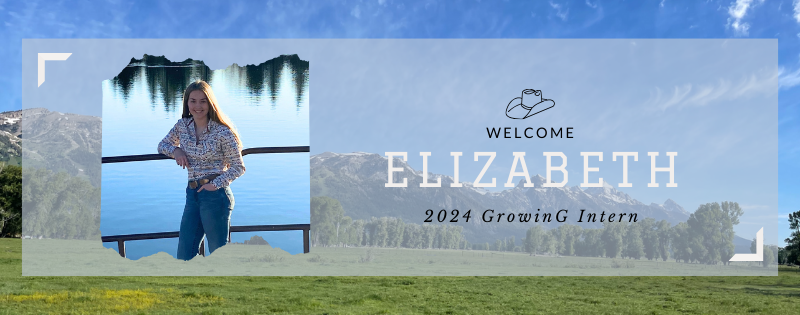A Sheep Week
#bfrdpwy #aginternship #RightRisk
I started off the week by doing a cattle drive with a ranch the host used to work for and helps out on every once in a while. This was an awesome experience, as I learned how to communicate properly with the people around me to ensure the drive ran smoothly. I also learned how to use the horse to keep the cattle off the road and driveways. It is important to work as a team to ensure the safety of the cattle and everyone involved. My host’s dogs and the ranch dogs joined us on the drive, and I was able to see the difference between using dogs with sheep and cattle. In this picture, you can see us moving the cattle.
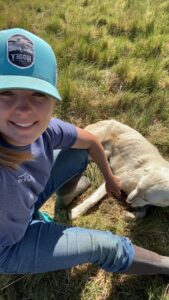
She also sold some of her sheep this week, so I was able to learn why she made this decision and how to load them in a trailer. She chose to sell these sheep as some of them have poor temperaments, which can be taught and passed on to their lambs. This can create an issue when you are trying to handle these sheep for various reasons, such as when you are sheering or doctoring. In this picture, you can see us loading the sheep in the trailer to go to their new home. I also learned how to maximize space when loading hay into a trailer and on a flatbed. My host was able to pick up free hay from her friend, so we wanted to load as much hay as we could within a small space. On the truck, it was important to stack it well, as we did not have a good way to secure it to the flatbed. I am on the top of the flatbed, helping load the hay in this picture. Lastly, I learned how to make felted dryer balls with leftover wool. This is a great product to make, as not all wool is of great quality, so finding a way to make use of it is important.
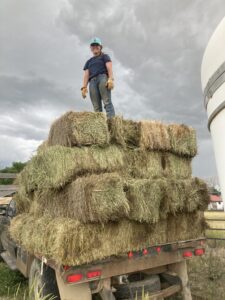
This week, I would like to challenge a better way to use guardian dogs. Right now, she has two guardian dogs named Iby and Poa. Iby stays with the sheep, and Poa stays with the chickens to protect them from predators, such as foxes and coyotes. The problem is that Iby has been having trouble staying with the sheep and wanting to roam. The solution that we have come up with is to tie her next to the fence so that she can not leave the sheep in the middle of the night. However, I do not think this is a great solution if there were to be a predator and she would need to have a confrontation. I believe that either training her to use different tactics to stay with the flock or using an electrical collar mapped out with a certain perimeter would be better. Here is a picture of Iby and I together.
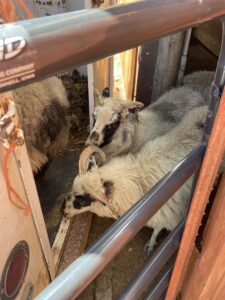
One of the questions that I had this week was about sheep temperament. I was wondering if a specific sheep’s temperament affects other sheep’s attitudes. Or if you were able to change or prevent a bad temperament when they were lambs vs. adults. This would be important to know as it can be a pain to handle an ewe with a poor temperament, so being able to avoid it without having to get rid of the ewe would be great knowledge. I was also wondering if this would be important with rams and if it is genetic or learned behavior. Another question I had was about training dogs with cattle vs. sheep. I would like to know if there is different training involved or what changes are needed. This information would help me better understand how to work dogs.
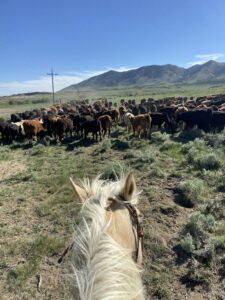
Being a part of a cattle drive adds to the versatile information I have learned during this internship. This has helped me narrow down what livestock and what I want to do in my career. As far as selling some sheep, I have learned how she makes decisions in her business. It is important to make decisions that better her business as well as her flock of sheep. This is a crucial perspective as most decisions in owning a business have to be carefully thought through in order to continue to operate. This will be extremely useful in any business I want to own or be a part of. My host has a lot of connections in the community that allow her to offset costs, such as the free hay. I have learned that a major part of owning a business is about who you know and being a part of the community. This will be important for me as I begin my career and start to network. Learning how to use dogs with different livestock, as well as livestock guardian dogs, is an essential consideration when owning livestock. These dogs have to be trained at a very young age and do not automatically know what they are doing, so understanding how to train them could be very useful.
Submitted by: Elizabeth Herman
Edits by: GrowinG Internship Team

